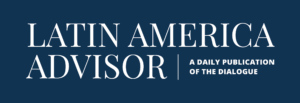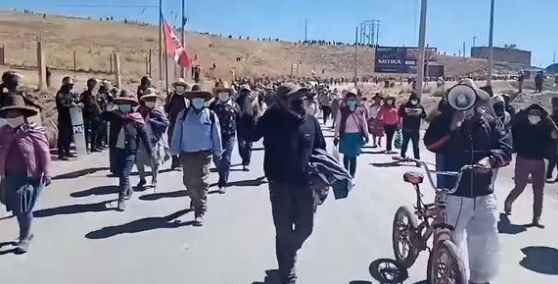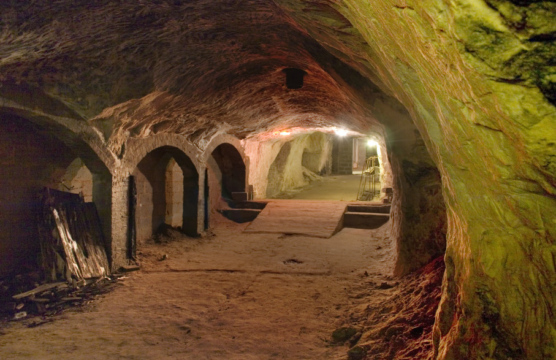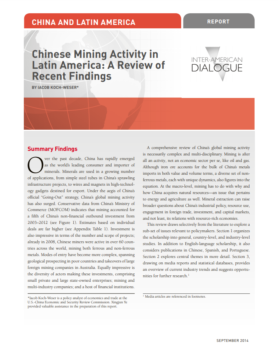As Mining Sector Takes Off, Colombia Must Take Care
Colombia is in the midst of a mining boom. The challenge for President Santos is to capitalize on the sector’s promise.
A Daily Publication of The Dialogue
Protests and roadblocks in Peru temporarily halted production in 10 mining areas last year, and Australian mining company MMG suspended production at its Las Bambas copper mine in December after talks with protesters broke down. Despite President Pedro Castillo’s promises to distribute mining profits more fairly, rural communities have complained about the pollution from mines affecting their drinking water, a lack of infrastructure investment or job creation and that the dust from heavy trucks is killing their crops and livestock. What can the leftist president do to address the concerns of local communities, while ensuring that output in one of Peru’s most important economic sectors is not compromised? How will investors react to the uptick of social strife and the government’s plan to increase taxes on mining companies? Is the situation likely to scare away new investment, and how possible is it that Peru sees capital flight?
Pedro Francke, Peru’s minister of economy and finance: “In the last two decades, mining has been the main source of social conflict in Peru. Although it is true that in recent months some protests have taken place, the ones that have been going on for years have been reactivated. It is also important to emphasize that today, Peru is not going through a period of great social conflict associated with mining. In the case of the Las Bambas copper mine and others, President Castillo’s government is prioritizing dialogue as a key tool to solve inherited conflicts by identifying underlying problems and seeking to build lasting solutions—not simply by reacting to outbreaks. At the same time, the government seeks to implement a preventative strategy against possible new conflicts. Mining companies are currently booming as a result of high mineral prices. It is estimated that the extraordinary income of mining companies in Peru exceeds $13 billion. We believe that under the current circumstances, it is convenient for the country to design instruments to better capture the income of mining companies without affecting competitiveness. Reforms to Peru’s mining tax is being designed with the advice of organizations such as the IMF and the World Bank, which provide not only technical capacity but also analysis compared to other mineral-producing countries. In addition, Peru’s copper mines have low production costs compared to other mineral producers. Peru will continue to be an attractive country for mining investment, and the bet is that this activity will continue to form a part of its productive model.”
Mercedes Aráoz, senior professor of finance at the Universidad del Pacífico and former vice president of Peru: “There are many myths around formal mining in Peru, which have been the banner of the radical left. Among the myths, it is said that the mines, being at the head of the basin, pollute the water. However, the water already comes with a high mineral content for geological reasons, even without mining activity. In all the recent cases of mines that have stopped their activities, the mines complied with the environmental, legal and social rules required by the Peruvian government. They maintain fluid relations with the populations that live in their areas of influence, with investments for those communities and the contracting of local workers according to previous agreements. Mining companies, for their part, have a tax burden of around 50 percent; in the case of income tax (30 percent), half of it is distributed between the regional governments and the neighboring municipalities. Many of these resources are not invested by these public entities, leaving communities unsatisfied in the provisions of public goods. It is also true that there may be some fair claims resulting from overpromising by state representatives. Many of the recent blockades were carried out hundreds of kilometers from the affected mines, led by people who do not represent the communities and who vandalized private property, affecting mining workers, and damaging camps and capital assets. In the case of Las Bambas, there are alternative solutions, such as the construction of a train to the port of Marcona (as the previous Kuczynski government discussed). Regardless of the ideology, community claims must be considered, but violence cannot be accepted as a mechanism for coercion.”
Luis Miguel Castilla, former Peruvian minister of economy and finance: “The Peruvian government has been ineffective in dealing with mining-related social conflicts, which account for two-thirds of all social and environmental conflicts in the country. Although most come from before, more radical factions within the current Castillo administration have encouraged unreasonable additional demands on mining firms. Local government authority has been curtailed, and short-term truces have only been achieved with unpredictable outcomes. Sustaining mining projects requires legal changes to make tax revenue distribution more equitable between regions, and urgent progress is required on public investment deployment (as more than 50 percent of tax revenues have not been reinvested into communities). While income redistribution is politically challenging due to zero-sum considerations among richer and poorer regions, public investment entails improving public services, but so far this has not been done. This means focusing on local capacity building and more transparency—most cases of corruption occur in resource-rich regions. More progress is critical to ensure that benefits from mining exploitation materialize and garner local support. While protracted social conflicts continue eroding Peru’s competitiveness, attempts to increase mining taxes would negatively affect the business environment. Nonetheless, this is less likely after Congress recently denied granting the government the legislative capacity to change the mining tax regime, which tripled fiscal revenues in 2021. In view of high international metals prices, promoting a mining FDI portfolio of $15 billion for this year seems to be a more sensible policy to boost government intake. However, investor confidence remains pessimistic and dampens prospects due to the higher regulatory risk.”
Augusto Cauti, former Peruvian deputy minister of mines: “To take advantage of the current positive prices of copper, the Peruvian government needs to address the concerns of communities on a pre-emptive basis, and with a regular presence, by using open and effective dialogue. The aim should be to address the needs of the surrounding communities, as well as the lack of infrastructure needed to develop other economic activities from taking place in those areas, while also responding to environmental concerns. Mining investors will continue to compare different locations in which to invest, and beyond considering the human and capital resources needed for each project, they will keep a keen eye on whether or not the government has resolved social conflicts. This is true for the development of mines in South America and around the world. Considering that mining activities can be highly capital-intensive over the long term, and in many cases, high-risk, investors will require stability, guarantees, safety and predictability in order to pursue new mining projects. Uncertainty and a lack of safety are real concerns for investors, so new investments could be delayed while investors wait for clear signals from the government. At the same time, mining projects under construction or in operation will be suspicious about changes to regulations if they are not consulted. If the mining protests persist, the government will be seen as lacking the authority to solve social strife that borders on criminal activity in some cases. The country cannot ignore this opportunity.”
 The Latin America Advisor features Q&A from leaders in politics, economics, and finance every business day. It is available to members of the Dialogue’s Corporate Program and others by subscription.
The Latin America Advisor features Q&A from leaders in politics, economics, and finance every business day. It is available to members of the Dialogue’s Corporate Program and others by subscription.
Colombia is in the midst of a mining boom. The challenge for President Santos is to capitalize on the sector’s promise.
Colombia has to remain competitive with other major producers such as Mexico to attract needed investment in extractive industries.
China has rapidly emerged as the world’s leading consumer and importer of minerals.
 Local opposition to mining projects forced the suspension of several projects last year in Peru. A protest near the Antapaccay copper mine in Espinar province is pictured. // File Photo: Peruvian Government.
Local opposition to mining projects forced the suspension of several projects last year in Peru. A protest near the Antapaccay copper mine in Espinar province is pictured. // File Photo: Peruvian Government.

